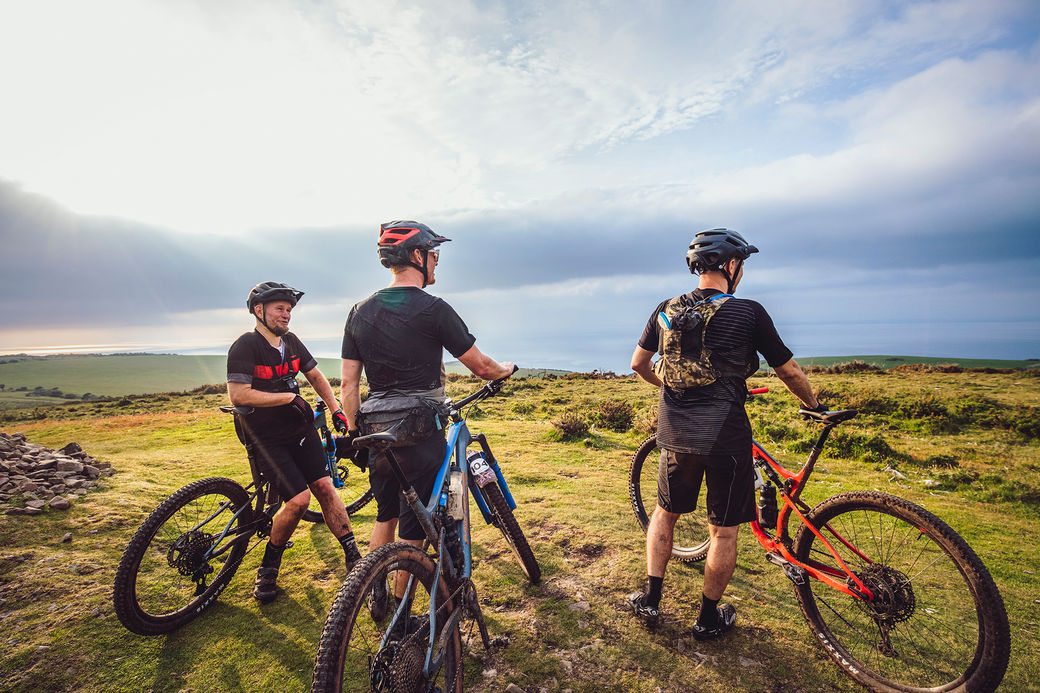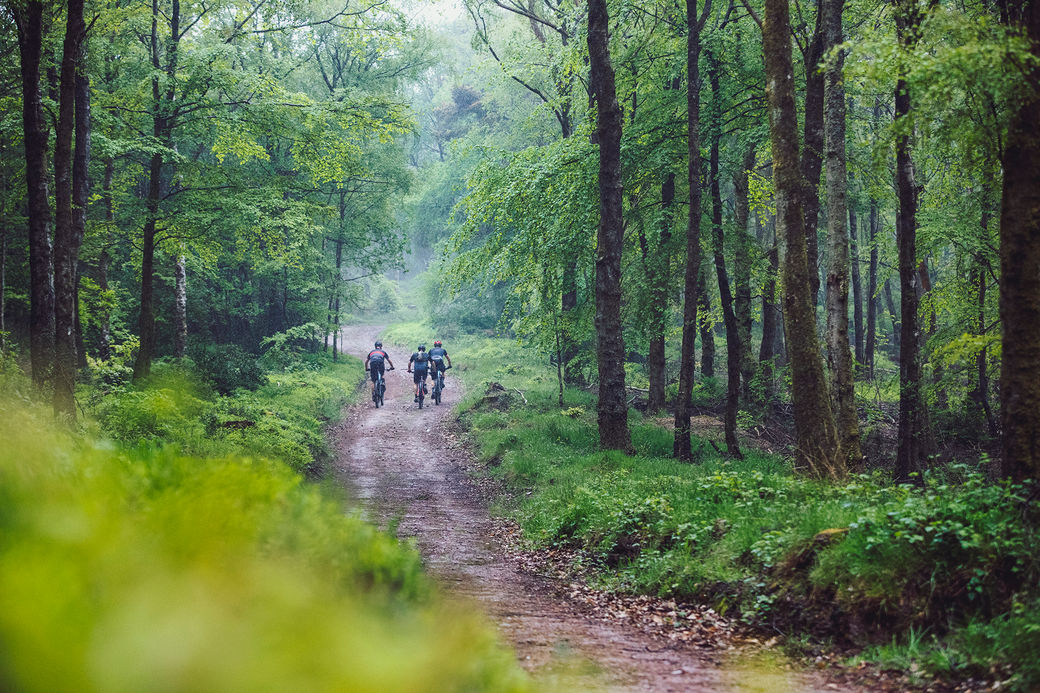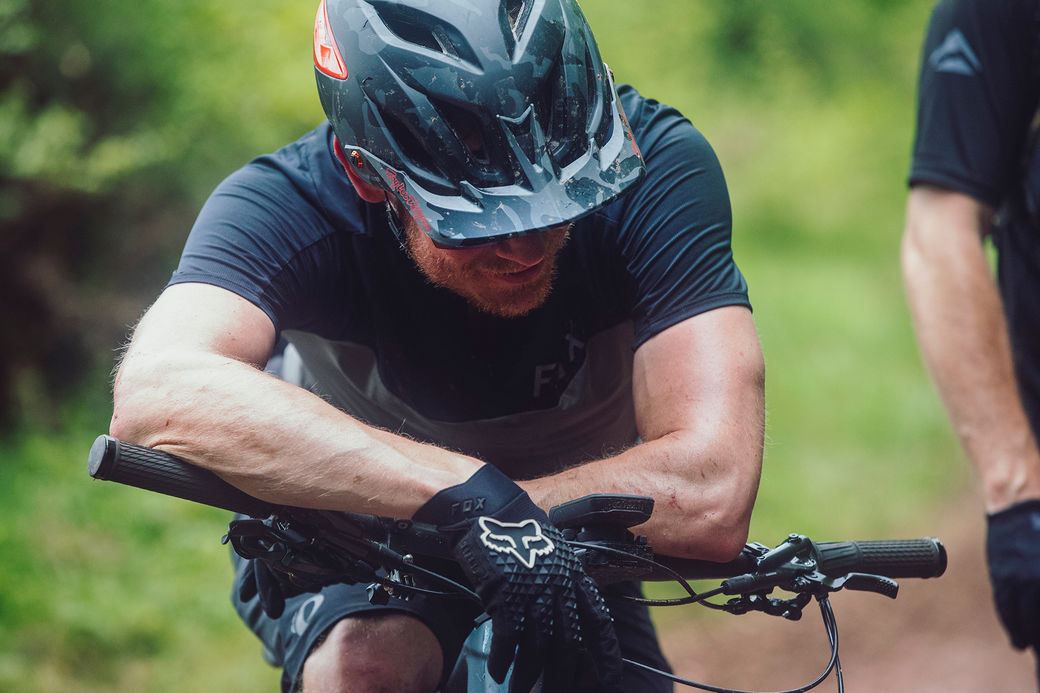Location & Language Selector
Please select location or visit OUR GLOBAL MERIDA WEBSITE
12 HOURS OF DOWN-COUNTRY
AMAZING DIY RIDING CHALLENGE
Like all good adventures, this one started with a simple enough idea. With the race calendar looking almost empty, but in need of a fitting challenge for the new NINETY-SIX lightweight cross-country weapon and our lockdown legs, MERIDA’s International PR manager Michael Wilkens decided that he’d take the classic 12 hour endurance racing format and turn it up a notch or two – by riding it on his local, tough enduro trails.
The thinking was simple enough; despite lockdown restrictions in the UK easing, it had been almost 18 months since ‚normal‘ events had been able to run – so why wait for other people to lay them on when you could just do it yourself? Add in the fact that the NINETY-SIX range comes in the longer travel, more trail-friendly versions, as well as race-focussed RC models and his vision, became clear – 12 hours of down-country riding, where the technical challenge of the trails would be just as high as the physical challenge of riding a mountain bike from dawn till dusk.
Michael is no stranger to running – or riding – events, having organised a number of rides and races in his time, but this would be the sort of challenge it would be hard for anyone to inflict on the general public, as steep, technical terrain and extreme fatigue are not a great recipe – so instead he roped in friends and colleagues, with Social Media Junior Manager Jon Woodhouse and journalist Tom Marvin from BikeRadar coming along for the ride.

Picking the right tool for the job was easy, with Michael and Tom selecting the NINETY-SIX 8000, which comes equipped for tougher trails as standard, with a 120 mm fork up front, powerful four-piston front brake and chunky Maxxis Minion tyres. Jon would be on the NINETY-SIX RC XT, which despite having 100 mm at both ends and a race focussed bias, was still more than up to the task thanks to modern, capable geometry and planted P-FLEX suspension.
Of course, the challenge would involve taking these bikes slightly out of their comfort zones, so each rider fine-tuned the machines to their own preferences. Michael and Jon opted for high-rise wide handlebars to give a more upright riding position that would be both more comfortable for the long rider and also give more leverage on the enduro-standard natural trails they would be riding. While the 8000 has aggressive tyres as standard, Jon opted to put on a more aggressive front tyre onto the RC XT, while retaining the fast-rolling rear tyre, admittedly with an insert to reduce the chances of a puncture. Both Michael and Jon switched to a smaller front chainring to give an easier gear – though Tom was confident he could still push the standard 34T ring all day long, and Jon’s Stages power meter cranks would allow him to monitor his effort and pace accordingly.
As the plan was to be self-supported on the trails and have a pit-stop location to refuel at, the ability of the NINETY-SIX to carry two full-size water bottles would come in very handy as it would allow them to extend their range and cover more ground before having to return. With the riding location set in an area of lush and varied natural riding, route choice would no longer be limited to laps of a race track, allowing the freedom to ride each trail as many times as they liked; changing the route to suit the weather or to mix up the riding as much as they wanted – with the option of stopping whenever they liked for a cooling ice cream or warming drink.

So, with the rough plan in place, the only thing to do was to set a date. With the vagaries of British weather mitigated for as best as possible, our trio found themselves ready to ride one slightly overcast morning. Despite it being a relaxed affair, the familiar feelings of race day still stirred up; trepidation at the challenge ahead, tempered with excitement of a day’s riding into the unknown. As with any endurance event, pacing and fuelling were key, each rider choosing their strategy according to their own strengths and weaknesses – pork pies, energy gels, sweets or fruit for fuel, heart rate monitors, power meters or intuition and experience to pace, whatever worked.
However, in this challenge, it wouldn’t be time to rest once the climbs were over, with a rude reminder of the technical challenge coming soon in the morning, as the haul out of the valley bottom up to the top of the first climb and spectacular views was swiftly followed by a testing, steep trail. It swiftly claimed the first crash of the day – and that in the knowledge that even with the best of care taken, it was unlikely to be the last.
Despite a bruising introduction, caution was thrown to the wind, with the ribbon of root strewn loam making an invitation to push harder that was hard to refuse. Sliding, whooping and yelling was the order of the day on descents, as our trio hustled the short travel bike down trails that would make longer travel machines work hard. With the buzz of adrenaline still coursing, it was then time to rinse and repeat, making the best use of the efficient bikes to cover ground, dispatching climbs with relative ease.
As the metres climbed steadily mounted and the distance grew, the British weather quickly made itself known and threw a spanner into the works, with torrential rain quickly soaking riders and the trails. While a conventional event would have been stuck, our freeform format meant we could head for the shelter of the woods instead of the more exposed open moorland.
While the woods offered sanctuary from the weather, the now damp trails took on an extra touch of menace, with drifty loam shifting to slippery mud. Wet, slick roots were ever ready to snatch at wheels, traction disappearing with little warning as the riders fought to balance momentum against grip, delivering up a fresh challenge but also thrills and a touch of exaltation upon making it downhill while still upright.
As quickly as it had arrived, the rain disappeared, just in time for the first pit stop of the day. With energy levels topped up, water bottles refilled and supplies of snack refreshed, it was time to head back into the fray, with the knowledge that the ride was yet to hit halfway, only slightly tempering the enthusiasm to get going again that a stop food and caffeine bring to a ride.
With ‚lunch legs‘ woken up again, the now warm but very humid conditions posed a challenge as the spectre of dehydration and the resulting – and possibly ride ending-cramp reared its head. Water bottles and hydration bladders were drained in an attempt to stave it off, and sweat flowed freely down faces and onto top tubes, but the drying trails kept excitement levels high.
The cycle of climb, descend, hydrate and feed ran on as the steady but sure pace was maintained, and the hours and kilometres racked up. That said, as riders switched places at the front of the train on the downhills, it was hard not to get a little overexuberant occasionally, still hopping and popping bikes of roots and kickers, though the frequency of slightly wild, barely-in-control moments rising as fatigue set in. The technicality of the trails still took its toll, with no one escaping unscathed as each rider pushed a little too hard and ended up off the trail – and sometimes bike – as a result.

As the sun began to wane in the evening, it was time for one last refuelling stop before the last push, topping to wolf down pasta and anything else that could be found, with faces starting to accumulate dust and grime as well as a somewhat faraway stare. Though still buoyant, the idle chatter and banter begin to become more sporadic.
It’s a brutal, steep climb to the top of the final descent, but tired legs are forced onward in the knowledge that it’s the last big effort, one rewarded with a view across the mountains and the sea. What goes up must go down, and the final descent is a cracker, with open moorland single-track giving way to a high-speed thrash that feels like it’s through a tunnel as the trees close in on either side and the light slowly fades. Fatigue is forgotten, and speeds increase as each rider duels, trying to take the lead via a cheeky inside line, trying to out-brake on switchbacked turns to eke out an advantage for no other reason than the joy of it.
It’s good fortune – and a bit of prior planning – that this descent finishes right at a pub on the coast. Though food-serving hours are finished, they take pity on a bedraggled but buzzing trio and the chef rustles up plenty of food, which is inhaled in moments as the sun gently sets over the horizon, washed down with cold and well-earned beer.
It’s a fitting end for a long day – with all the struggles and hard effort quickly forgotten in the joy of having completed our challenge, the buzz of an organised event present despite the lack of number boards or finisher’s medals. The last drink is barely finished before the possibility of another challenge has been raised – a sure testament to the fact that good times on good trails – and of course, good bikes – is excuse enough.
WHAT WE LEARNED
FROM CREATING OUR OWN ADVENTURE
If this has inspired you to try and take on a challenge of your own, we learned a few key things along the way, so here are some key points:
- Our NINETY-SIX bikes, whether in ‚normal‘ or ‚down-country‘ guise, were more than up to the task. Having a reliable companion that made light work of the climbs but offered confidence on the descents mean that we could just get on with the business of riding.
- Fuelling and hydration was critical and it takes effort and discipline to keep energy up on a long rider such as this. Forcing yourself to eat and drink when you might not be feeling hungry or thirsty means that you never fall into a zone of energy deficit or suffer from cramp, something that can make a ride deeply unpleasant – or even end it.
- Fine-tuning our bikes to the specific task at hand was crucial – changes to gearing made life much easier at the end of a long day, while the changes to the tyres set-up on the XT RC were critical especially once the weather changed from dry to very damp. Take into account what sort of terrain you’ll be on and adapt your set-up to suit. Having no fixed plan or route allowed us to roll with the punches, such as moving from exposed areas to more sheltered ones when the rain struck, something well worth considering when your choose your location. Having that flexibility made the ride much more pleasant and while it meant we didn’t ride some areas, we can always do that next time…
- While organised events will return and will be just as enjoyable as they ever were, just heading off into the hills with your mates is one of the most rewarding things you can do on a bike. Lockdowns have taught us that the social part of cycling is just as important as the activity itself, so there’s no time like the present to get your riding buddies together and make your own challenge – whether it’s big or small, it’ll be worthwhile.
WATCH MORE VIDEOS
How to set up a cross-country bike for enduro trails
WATCH ON YOUTUBE
Want to make your own DIY MTB event?
WATCH ON YOUTUBE